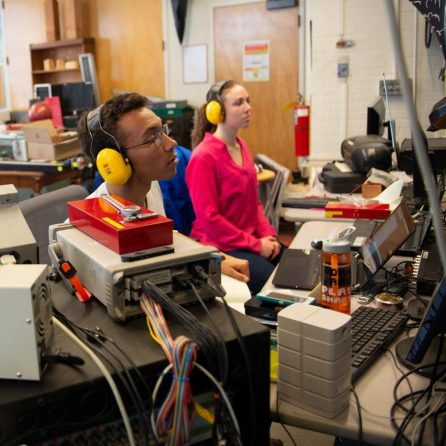Research Opportunities

- View current undergraduate research opportunities in AeroAstro.
- Post an AeroAstro research opportunity (For AeroAstro labs only. Touchstone login required to access form.)
You don’t have to be a graduate student to do research in AeroAstro — we have a range of research opportunities in which you can work, sometimes as early as your first year at MIT. As a participant in the Undergraduate Research Opportunities Program (UROP), you can work with faculty as a junior colleague in every phase of their research: developing plans, writing proposals, conducting research, analyzing data, presenting research results. You may find yourself working on a project sponsored by the FAA, NASA, or a private aerospace company. UROPs are a great way to explore aerospace research, prepare for graduate school and future careers, connect with faculty and apply classroom learning to real-world research.
UROPs take place during the academic year and over the summer. Projects may last for an entire semester; some continue for a year or more. UROP students receive academic credit, pay, or are volunteers, depending on the project. A UROP may not be pursued for both pay and credit within a term. Ineligible for UROPs are special students, students on leave from MIT, and students who have completed their degree program (unless they stay registered to finish a double major).
If you’re interested in particular research areas, you should:
- read our list of current Undergraduate Research Opportunities
- visit our UROP supervisor listings to identify individual faculty research interests
- contact the supervisors to see if they have a UROP opportunity available
- watch for emails from the AeroAstro Undergraduate Office about AeroAstro UROP openings
- visit the MIT UROP website to see openings elsewhere in the Institute
If you have general UROP questions or concerns, contact UROP coordinator Marie Stuppard.
Current AeroAstro Research Opportunities
View current AeroAstro undergraduate research opportunities below. Submit an opportunity (Note: Touchstone login required.)
Open opportunities are listed in chronological order, with the most recent submissions at the top.
Paid/Credit UROPS
Paid UROP
To obtain a paid UROP, students must submit a proposal for direct UROP or research-sponsored funding by the Institute’s UROP deadline. During the fall and spring terms, most students typically work 12 hours per week and as many as 40 hours per week during IAP and the summer. MIT has an established hourly rate for UROP pay, however, at the discretion of a UROP supervisor and the department, students whose stipend is covered through research funds may earn a higher rate. Students are expected to keep track of their worked hours and submit electronic timesheets on a weekly basis. Students paid through direct UROP funds need to print their weekly timesheets for approval by their direct supervisor and bring a copy to the Course 16 student financial administrator Carol Niemi, Room 33-208. If students decide not to pursue a UROP after it has been approved, it is advisable that they immediately notify the research supervisor, the UROP Office, and Carol Niemi.
In accordance with U.S. immigration law, all student workers (and other MIT employees) are required to provide proof of identity and authorization to work in the United States. Before they can be paid, new student workers must complete Section 1 of the I-9 form electronically in MIT’s online system. The employee/student worker has three business days from hire date to present original supporting documentation in person to the Atlas Service Center.
Credit UROP
Credit UROPs can be performed during the academic year and over the summer. Note that few students enroll in credit UROPs in the summer as tuition charges will be applied.
To do a UROP for credit, students submit a proposal <http://web.mit.edu/urop/apply/index.html> by the Institute’s UROP deadline and register in WebSIS <http://mit.edu/studentserve/websis/> for 16.UR (pass/fail) by Drop Date. An AeroAstro student doing a UROP for credit outside of the department registers for a UROP number in that department (e.g., 2.URG, 6.UR, 8.UR). The number of units a student earns is equal to the number of weekly hours devoted to the project. At the end of each term, AeroAstro UROP supervisors submit a grade and an evaluation of the student’s performance on the project. Credit hours may be adjusted at that time if the supervisor deems that the student has worked fewer or more weekly hours on the project.